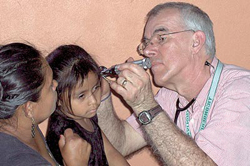NORTH COUNTRY MISSION OF HOPE
Dominican Sister brings images, stories
of
Nicaragua’s suffering
to local students
Heather Felton, of the Florida Catholic staff
SARASOTA — Pictures
of skinny Nicaraguan children, their bellies bloated with parasites,
standing barefoot in the red dirt and with little to no clothing,
were projected on the whiteboard in the Incarnation School
classroom.
The students stared at the children in the pictures, not so
different from themselves, as Sister Debbie Blow, Dominican Sister
of Hope, asked them what it was they had done to be born here
in America into this lifestyle.
“Nothing,” one student answered.
“And what did these children,” she asked, referencing
the pictures on the wall, “do to be born there?”
The same answer came back to her: “Nothing.”
There are many reasons to help these people, she said. We are
Christians and Catholics and Jesus told us to feed the hungry
and clothe the naked, but that is not the only reason.
“The bottom line, boys and girls, the bottom line is because
we can.”
Sister Blow, executive director of North Country Mission of
Hope, visited third- to seventh-grade students at Incarnation
School in Sarasota March 26, and fifth- to seventh-grade students
at Epiphany Cathedral School in Venice March 27, sharing the
realities of life in Nicaragua for the poorest of the poor and
the mission’s work to help the people there.
Nicaragua, she told the students, is the second-poorest country
in the hemisphere, after Haiti. The country has a 65 percent
unemployment rate and the average income is $350 a year.
“How much does an iPod cost?” she asked.
“About that,” the students responded, looking awed.
A nonprofit corporation, North Country Mission of Hope is a
multidenominational humanitarian organization headquartered in
Plattsburgh, N.Y., and operates in Managua, Nicaragua.
Sister Blow’s presentation affected the students who heard
and saw it.
“I think a lot of people would think it’s bad to
not have toys,” said Jared Muha, 12, “and they
don’t even have food. We’ll eat something and throw
it away if we don’t like it. The (people in the dump) eat
what other people threw away.”
“It’s kind of sad,” said Lauren Schofield,
13. “I can’t imagine having to live like that.”
Haley Paulsen, 13, agreed.
“We’ve heard about stuff that’s bad, but the
pictures are a hundred times worse,” she said.
“How they can live like that and survive … or not,” added
Jordan Gonzales, 13. “I take shoes and socks for granted.”
Sister Christa Cunningham, a fellow Dominican Sister of Hope
and organizer of Sister Blow’s visit to Epiphany Cathedral
Parish, was also touched by the presentation.
“(It brought home) simple things, such as turning off
the water when brushing your teeth; the people who don’t
have commodities that we take for granted; people living in cardboard
boxes. It just brought tears to your eyes,” Sister Cunningham
said. “The number of missionaries she takes over there — especially
the ones from high school — that must have an impact on
their lives, having a chance to see world situations that can
really affect them.”
North Country Mission of Hope began in 1999 as a “direct
ministerial response to the catastrophic effects of Hurricane
Mitch on the impoverished villages of Chiquilistagua and Monte
Verde in Nicaragua,” states the mission’s Web site. “The
first mission team immediately recognized that direct, long-term
assistance was vital in order to improve the lives of the people.
“Working hand in hand with local community leaders,” the
site states, “the mission’s primary objective is
to empower the people to help themselves through educational,
health care, nutrition, water and community development projects.
In addition, by enlightening the area students and adult missioners
to the conditions and needs of the poor, we are able to bring
about changes in our own communities.”
One of the areas under focus for the mission is the Managua
city dump that serves as a home for more than 600 children and
their families, Sister Blow said. The homes are made of trash
bags or cardboard boxes and a family’s “home” is
roped off with barbed wire.
“Most of the children I work with eat once every three
to four days, if they’re lucky,” she said.
But through the mission, sponsors from across the globe support
children or families and help them to secure better housing,
uniforms and shoes for school, regular meals and clean drinking
water. In addition, the mission conducts two weeklong trips to
Nicaragua with groups of 25 to 40 people of various ages, although
it hopes to expand to three mission trips per year.
So far, Sister Blow said, the mission had participants from 18
high schools, 14 institutions of higher education, 11 states — including
Florida — and 10 countries. From December 1998 to February
2007, 623 individuals have participated in at least one of the
23 mission trips; 136 have made more than one trip. Sister Blow
is hoping to add more people from more places to that list.
“If I can change your heart, then you can be a miracle
for another child,” she said.
And the financial cost to help is so little, she said.
“If you gave up one soda a week, you could a save a child
from starving,” she said. For $120 a year, a child can
be fed a hot meal a day, as well as be provided with a school
uniform and shoes and a yearly doctor visit.
“We know from what we hear in church that God hears the
cry of the poor,” Sister Blow asked the students. “Will
you?” |






